The articles within the PDF at the bottom of this page were originally published in UFO Magazine, Vol. 4, No. 2 (1989), and are archived here for research purposes.
This special section of UFO Magazine compiles three in-depth articles that tackle the controversial use of hypnotic regression in UFO abduction research. While the technique has been widely used by investigators seeking answers to “missing time” and alleged encounters, these pieces present contrasting views from within the field, examining both the potential value and inherent dangers of the method. The discussion includes perspectives from a well-known abductee and author, one of the field’s most prolific investigators, and a folklorist who brings an academic lens to the issue. Each article contributes to a broader understanding of whether hypnotic regression can truly be trusted to uncover fact — or whether it risks distorting what little is known about these mysterious experiences.
Whitley Strieber – “Technique Out-Of-Control”
In a strongly critical piece, Whitley Strieber outlines his concerns with the use of hypnotic regression in UFO abduction investigations. Best known for Communion and Transformation, Strieber describes how his own experiences led him to seek hypnosis, but quickly warns that the technique is vulnerable to misuse — particularly by untrained or ideologically driven investigators. He writes, “I have seen what I feel are abuses perpetrated by ‘investigators’ who are really nothing more than part-time, unlicensed and unregulated mental health counselors.” Strieber argues that regression, while potentially helpful in therapeutic settings, should not be used to establish factual narratives about alleged encounters. He contends that suggestibility, confirmation bias, and lack of proper oversight have led to a distorted view of what abduction experiences entail. Instead, Strieber urges the community to focus on conscious, unhypnotized testimony and to avoid prematurely shaping narratives around investigator expectations. His warning: unless treated with proper scientific and ethical rigor, hypnosis may do more to conceal the truth than reveal it.
Budd Hopkins – “One Ufologist’s Methodology”
Budd Hopkins, often credited with bringing abduction research into the mainstream, offers a defense of hypnotic regression and lays out his methodology in detail. He began using the technique in the late 1970s after investigating multiple cases that featured missing time and recurring trauma. Hopkins emphasizes that hypnosis is not the first tool he reaches for, but rather one he uses after exhausting conventional interviews and investigative steps. “In roughly one-fourth of the abduction cases I’ve investigated, the subject has recalled virtually all of his or her basic abduction scenario prior to hypnosis,” he writes. Hopkins also stresses the importance of using neutral, non-leading language and notes that the details recalled by abductees—whether hypnotized or not—tend to align. He introduces concepts such as “screen memories,” where the mind masks traumatic encounters with benign imagery, such as owls or deer, to protect the witness. Hopkins maintains that hypnosis, when used responsibly, has helped uncover consistent patterns in abduction cases, including apparent medical examinations, reproductive procedures, and the recurrence of experiences over a witness’s lifetime. He warns against throwing the tool out entirely, stating that “screen memories clearly establish the need for hypnosis if we are ever to know the whole truth about any abduction experience.”
Dr. Thomas Bullard – “Hypnosis No ‘Truth Serum’”
Dr. Thomas Bullard, a folklorist with a Ph.D. from Indiana University, approaches the topic from an academic and methodological standpoint. His article focuses on whether hypnosis can be considered a scientifically valid tool in abduction research. Citing decades of psychological literature, Bullard explains that hypnosis is not a form of “truth serum,” but a complex process that can lead to both enhanced memory and increased susceptibility to suggestion. Bullard compares 104 abduction cases—74 derived from hypnotic recall and 30 based on conscious memory—and finds that the two sets of data are broadly consistent. He notes that “in nearly 3/4 of the time, the results were homogeneous among hypnotic and non-hypnotic cases.” While some traits—such as undressing or implants—appear more frequently in hypnotic sessions, Bullard argues that the overall structure and content of abduction reports are not significantly distorted by the use of regression. He also addresses experiments where non-abductees, when guided under hypnosis, generated fictional abduction stories. Though these raise valid concerns, Bullard concludes that they don’t account for the internal consistency and recurring patterns found across genuine cases. His final assessment: hypnosis has limitations, but when used with caution, it remains a viable tool—one that must be paired with corroborating evidence, multiple-witness cases, and physical data.
Together, these articles offer a balanced and critical look at hypnotic regression and its place in abduction research as it stood in 1989. The technique continues to be a point of contention, with opinions split between those who see it as a doorway to hidden truth and those who see it as a source of contamination in the historical record. As with much in the UFO field, the debate remains unsettled — but this collection adds important context to an issue that sits at the heart of how we investigate one of the phenomenon’s most persistent mysteries.
Document Archive
